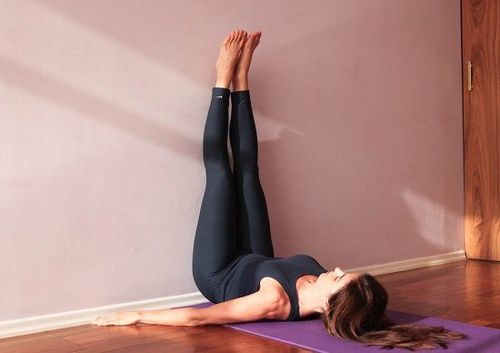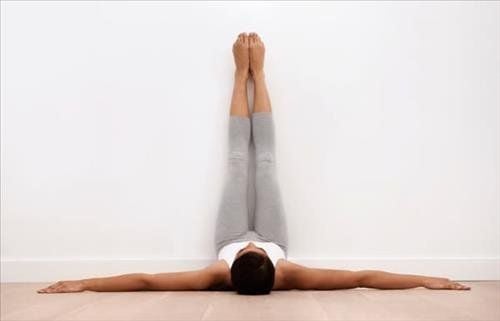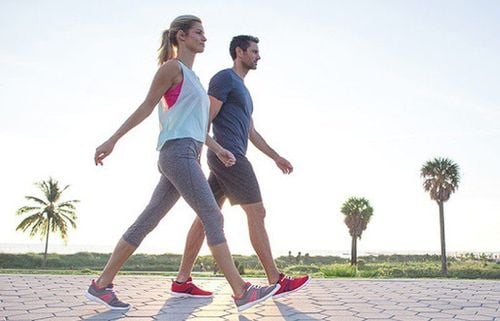Practicing the leg-up-the-wall yoga pose correctly and regularly can offer several health benefits, such as enhanced blood circulation, reduced stress, and improved sleep quality. However, many people experience numbness or discomfort in their legs while holding this pose. So, is it acceptable to perform the leg-up-the-wall pose if you start to feel numbness in your legs?
1. What are the benefits of putting your legs up the wall?
Putting your legs up the wall (also known as Viparita Karani) is a pose in restorative yoga exercises. This easy-to-do pose brings many health benefits without the practitioner needing to warm up or prepare anything beforehand.
To do the leg-up-the-wall pose, the practitioner does not need the help of any tools, instead, just lie on your back, then bring your buttocks close to the wall and straighten your legs. If you feel uncomfortable, you can use a soft pad under your buttocks, a blanket under your head, and a strap around your thighs.
The leg-up-the-wall pose brings some health benefits as follows:
- Increased detoxification: Raising your legs will stimulate metabolism, improve blood circulation to organs (such as the liver and kidneys), and create an extreme detoxification reaction;
- Improve skin: When you put your legs up the wall, blood circulation will take place faster, and at the same time the body temperature will increase, stimulating sweat secretion, thereby opening the pores and increasing the elimination of harmful substances. Therefore, the skin gradually changes in a positive direction, becoming younger after each practice;
- Prevent constipation and stimulate digestion: When the legs are raised, the body has many positive changes, increasing gastrointestinal motility, thereby helping to prevent constipation, improve digestive function, and limit the risk of liver and intestinal diseases;
- Improve mood and lower blood sugar: According to Traditional medicine, the spleen is an organ that directly connects with the limbs. Therefore, when the legs are raised high, it will stimulate the spleen to work more strongly, thereby helping to stabilize blood sugar and improve the function of the spleen and stomach. The patient's mood is also somewhat more stable, balanced, and calm;
- Reduce stress and improve sleep: According to Traditional medicine, putting the legs up the wall before going to bed helps the practitioner have a quality sleep. As soon as the legs are raised high, the pressure in the brain is reduced rapidly, thereby relieving stress, and anxiety and improving sleep quality quickly;
- Reduce the burden on the lungs: When performing this yoga movement, the solar plexus area will also be trained and increase the supply of oxygen to the lungs, thereby helping to reduce the burden and enhance lung function;
- Protect the spine and prevent osteoarthritis: When placing your legs straight up the wall, the lumbar spine will be kept flat and stable, at the same time the muscles of the whole body have flexible elasticity and blood circulation is favorable, maintaining joint function. The result is the restoration of nerve function in the spine and pelvis, protecting the spine and preventing degeneration;
In addition, some other benefits of the leg-up-the-wall pose include helping to improve headaches, migraines, nausea, and varicose veins; Giving the legs time to rest after a day of physical activity; Balancing hormones.

2. Is it normal to put your legs up the wall and get numb?
This yoga pose can be simple and easy to do. It can bring many health benefits, but some people experience numbness in their legs when putting them up the wall, accompanied by pain or discomfort. According to experts, numbness in the legs when putting them up the wall is a sign that the body's injuries are in the process of recovery, so it is usually not serious and does not require any treatment.
However, putting your legs up the wall and getting numb can be the result of performing the wrong posture or method. Therefore, an important requirement is that the practitioner must ensure that the posture is performed correctly according to yoga standards. If there are any questions or concerns about whether putting your legs up on the wall and getting numb is okay, the practitioner should discuss it directly with the coach or instructor.
3. What to do if your legs go numb when you put your legs up against the wall?
Putting your legs up the wall can stretch the muscles of both legs but rarely causes pain or numbness. If your legs go numb when you put them up the wall or experience other discomfort, the practitioner just needs to gently change the position of your buttocks away from the wall until you feel most comfortable.
In the beginning stage, the practitioner should only maintain this position for about 3-5 minutes and when they have adapted, increase the practice time to 10-15 minutes. However, if the condition of putting your legs up the wall causes numbness in the legs (including the legs or calves) to the point where it is unbearable, the practitioner should comfortably lower the legs down the wall, temporarily rest and exit the position.
If the numbness in the legs when putting your legs up against the wall still does not improve, the practitioner should talk to a doctor for specific instructions on how to fix it.
4. How to do the leg-up-the-wall pose correctly
The leg-up-the-wall pose can be performed relatively simply and sometimes without the guidance of a yoga instructor. However, if practiced incorrectly, it can sometimes cause many uncomfortable signs such as pain or numbness. Therefore, the best way is to go to professional yoga classes to discuss and receive guidance from the instructor. In addition, practitioners can learn how to perform this beneficial pose through instructions on the internet.
Here are the steps to perform the leg-up-the-wall pose:
- Place a soft blanket or yoga mat on the floor, next to the wall, and use a small pillow to support the head when necessary;
- The practitioner lies on his back with the buttocks placed close to the wall. It is best that the tailbone is still placed on the floor and the buttocks are as close to the wall as possible. Keep the back and head in line and perpendicular to the wall;
- Raise the legs and lean against the wall, relax the knees, and legs in a position parallel to the floor. At this point, the practitioner will feel the 2 legs stretch, but often create a painful feeling;
- Slowly breathe deeply and relax for 2-3 minutes or maintain this movement longer if adapted;
- When the goal is completed, the practitioner should slowly exit the leg-up-the-wall pose. Then carefully and gently move to a sitting position, holding still for at least 30 seconds.
Some notes when performing the leg-up-the-wall pose:
- The practitioner should choose comfortable clothes to completely relax the body, limiting blood circulation obstruction;
- This movement is not suitable for people with recent or chronic leg or spine injuries;
- Some common mistakes people make are lying too far or too close to the wall, placing a pillow or blanket that is too soft under the back... because it can lead to muscle tension and hinder spinal balance;
- This movement can be performed at any time except for about 30 minutes after eating;
- It should be done twice a day, in the morning and at night before going to bed.

5. Who should not practice the leg-up-the-wall pose?
In addition to the condition of numb legs when putting them up the wall, this pose, like other yoga exercises, can also bring some risks and contraindications. Therefore, the following cases should avoid performing this pose:
5.1. Increased eye pressure
Normal physiological inversion poses such as putting your legs up the wall have been shown to increase eye pressure (also known as fluid pressure in the eye). Therefore, this yoga pose is considered unsafe for patients with glaucoma. Experts say that although eye pressure can return to normal when the patient returns to a sitting position, it is best to avoid performing the leg-up-the-wall pose in cases of glaucoma.
5.2. Conditions that cause edema, fluid retention
Patients with certain medical conditions that can cause excessive fluid accumulation in the body (or edema) should avoid doing the legs-up-the-wall pose. Patients should not attempt this pose on their own or, if they do, they should do it under the guidance and supervision of a healthcare professional, because doing so can cause a large amount of fluid to return to the circulatory system and overload the heart. Some medical conditions that cause fluid retention include:
- Congestive heart failure;
- Kidney failure;
- Liver failure or cirrhosis.
5.3. Uncontrolled blood pressure
Individuals with high blood pressure who have not controlled it or cannot manage it should avoid the yoga pose of putting their legs up the wall, as this position may further increase blood pressure. However, once blood pressure is stable and well-managed, individuals can safely practice this pose to help alleviate various health issues.
I hope the information in this article has clarified whether it's safe to put your legs up the wall and whether numbness may occur. If you have any questions or concerns, it is advisable to consult directly with a trainer or instructor.
Follow the Vinmec International General Hospital website to learn more about health, nutrition, and beauty to protect the health of yourself and your loved ones in the family.
To arrange an appointment, please call HOTLINE or make your reservation directly HERE. You may also download the MyVinmec app to schedule appointments faster and manage your reservations more conveniently.








